Mastering strategic goal setting: Proven methods & expert guide for success

Aligning a company’s overall vision with the day-to-day tasks can prove to be a challenge. In such cases, strategic goals serve as a bridge between the company’s vision and strategy. Strategic goals are therefore essential for a company’s success.
This article explains what strategic goal setting is, why it is relevant for businesses, and what the dos and don’ts of strategic goal setting are.
What to expect:
- What is strategic goal setting?
- Why should companies set strategic goals?
- Why can strategic goal setting fail?
- The five steps of strategic goal setting
- Methods and frameworks
What is strategic goal setting?
The first step when creating a company’s strategic plan is to establish a strategic goal that should be achieved. Strategic goals are long-term, specific, and measurable objectives that serve as guidelines for a company’s strategic planning process. By setting strategic goals, companies aim to provide direction and maximize efficiency amongst all shareholders toward the ultimate business goal.
When setting goals, it is important to differentiate between strategic, tactical, and operational goals.
While strategic goals tend to be aspirational long-term goals with a broad focus, tactical goals are more quantitative medium-term objectives that focus on individual business departments. Tactical goals are necessary to achieve strategic goals. On the other hand, operational goals, which are the daily tasks executed by a team, lead to the achievement of tactical goals.
Setting strategic goals can be a difficult task. This is why it’s important to acknowledge the different characteristics between the types of goals to avoid setting strategic goals at the wrong level.
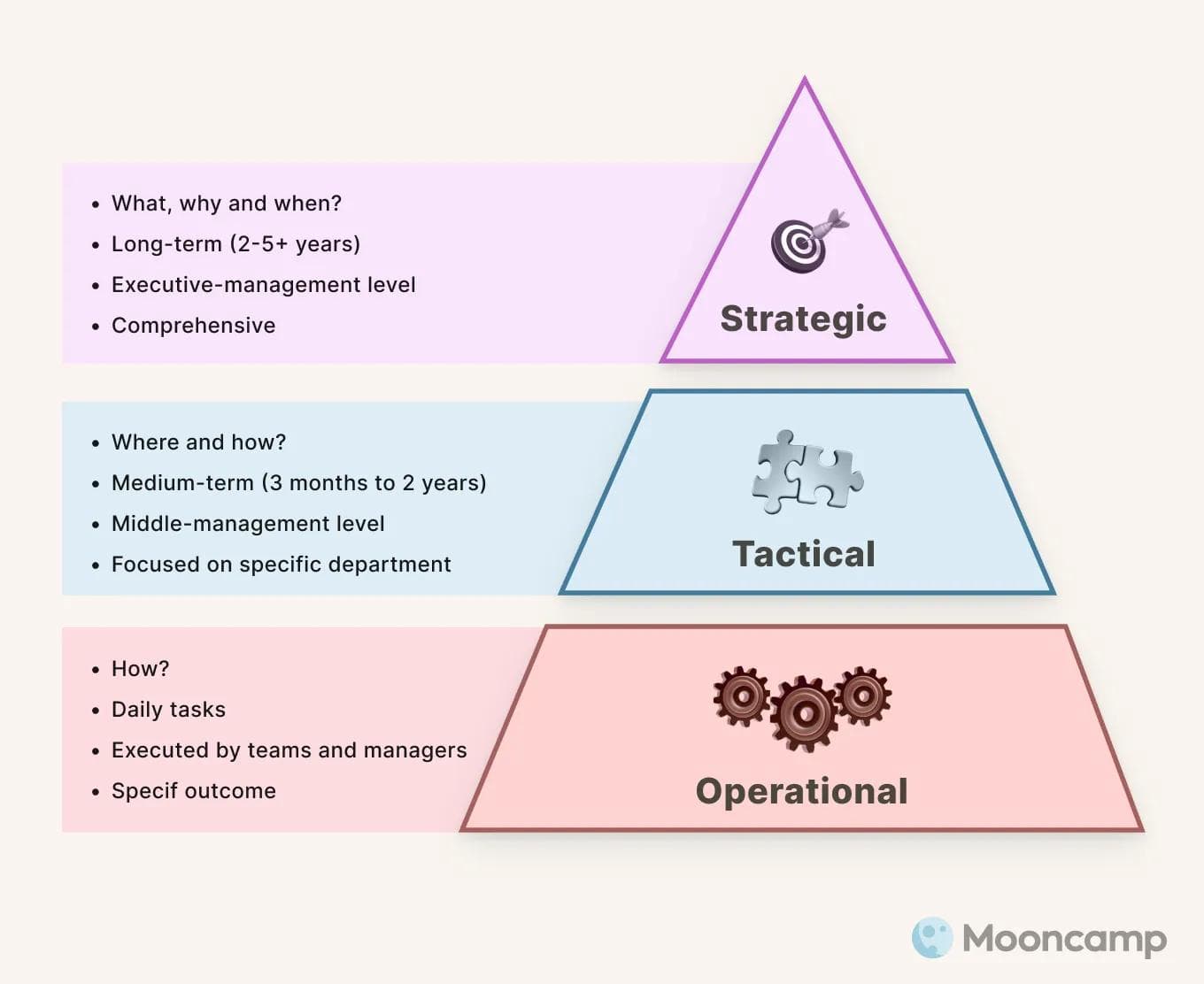
Characteristics of strategic goals
Purpose-oriented
Strategic goals can refer to both financial and nonfinancial objectives, they can therefore take on many different forms depending on the desired outcome. Nevertheless, all strategic goals are defined by their purpose-driven characteristic: they aim to achieve the company’s desired future state.
Long-term
At their core, strategic goals are built on the company’s values and vision while attempting to have a long-lasting impact. Unlike tactical and operational goals, strategic goals consist of long-term objectives which are meant to last 3 to 5 years.
Tip: It is ideal to have a forward-focused vision when setting strategic goals, to ensure that the objective is challenging enough to have a long-lasting effect.
Actionable
Apart from being long-term and forward-focused, strategic goals are also actionable. An unrealistic strategic goal with unachievable operational goals can be a waste of time and resources. This is why the operational and tactical goals that are needed to complete the desired strategic goal should be analyzed when formulating said goal. This ensures that the strategic goal consists of doable steps.
Measurable
Despite being aspirational, strategic goals are also measurable. They rely on metrics to identify possible areas of improvement and to assess the goal’s progress as well as success. These metrics are called key performance indicators (KPIs) and are used to track the performance of a strategic goal.
In essence, strategic goals should be broad, but should also be specific enough to be measurable — vagueness should be avoided.
KPI examples
- Revenue growth: measures how much revenue the company generates over a period of time.
- Gross margin: this measures how much profit the company earns on each dollar of revenue. It can be used to track product profitability or to compare performance against competitors.
- Customer churn: depicts how many customers leave the company over a given period. It helps identify areas of improvement and can pinpoint which aspects of a service or product are responsible for low customer satisfaction.
- Employee turnover: the turnover measures how many employees leave the company over a given period. A high turnover rate indicates that the company needs to improve its employee retention rate.
- Social media followers: this metric measures how many people follow your company across all social media platforms. Follower numbers can indicate the strength of the company’s brand awareness or engagement levels.
- Website visits: this metric shows the number of people that visit a company’s website over time. It can help track the company’s online visibility or marketing efforts.
Why should companies set strategic goals?
The importance of goal setting in companies has been prevalent since the 1960s when Lock and Latham first introduced their goal setting theory — now considered one of the most prominent theories of motivation.
But what are the specific benefits of strategic goal setting for companies?
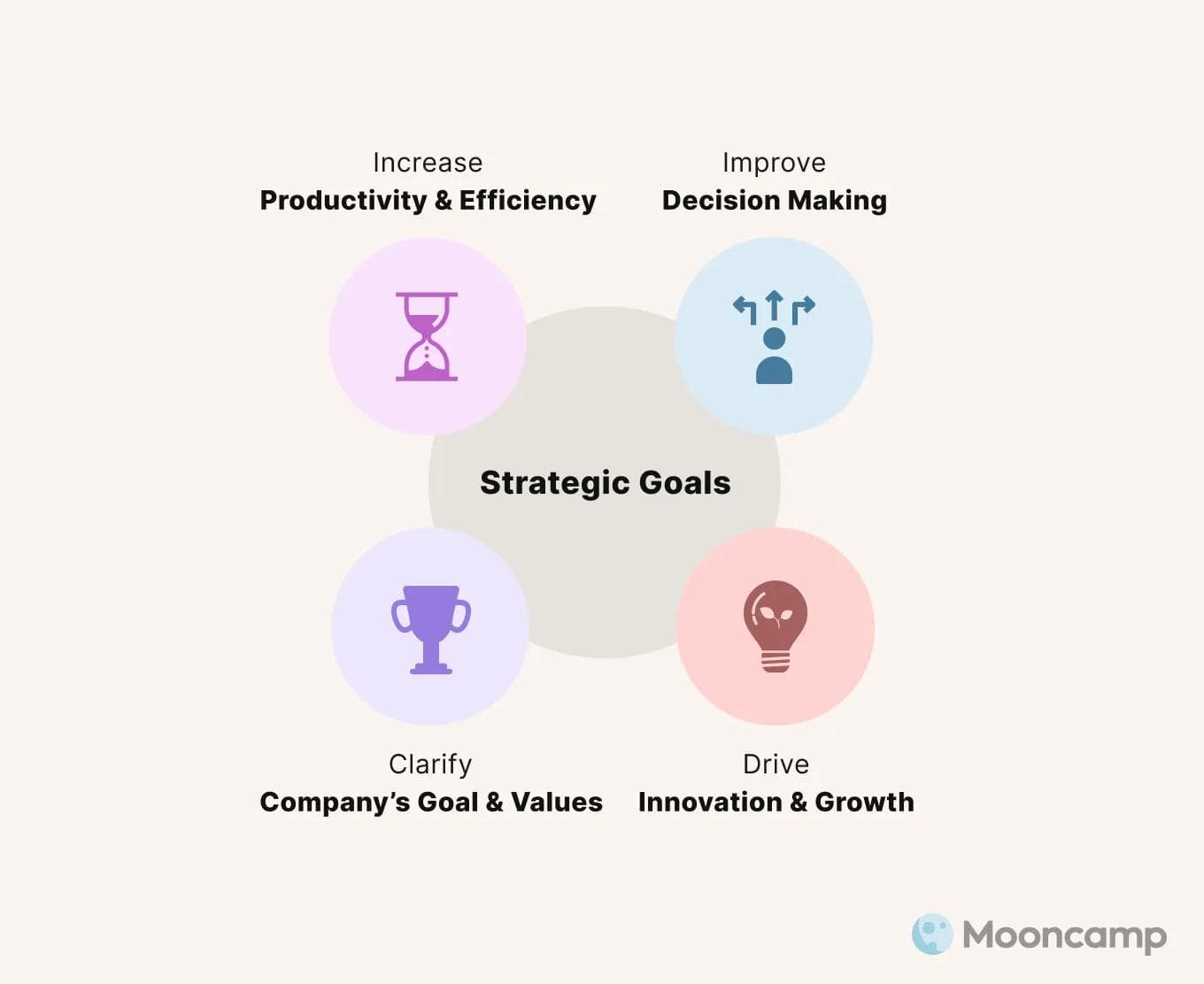
Provide clarity
Strategic goals can help employees understand the company’s vision and where it’s heading. A clear mission allows individuals and teams to focus all of their efforts and resources toward the specific objective, minimizing distractions and increasing efficiency. Additionally, strategic goals can also help improve communication amongst teams and organizations by ensuring that everyone is aligned and working towards the same objective.
Increase motivation and engagement
Clearly defined goals do not only improve work efficiency amongst teams, but they can also increase the overall motivation among employees. The clarity that strategic goals provide helps employees understand the importance of their tasks and gives them a sense of purpose. This can lead to better engagement rates, improve individual decision-making, and increase productivity.
Drive innovation
As mentioned, strategic goals can provide transparency about the company’s goals and its tasks. This transparency not only leads to an increase in motivation, it also leads to more innovation within the company.
Setting strategic goals encourages employees to think of new ideas and implement new approaches. When employees thoroughly understand the ultimate goal as well as the relevance of their tasks they become more confident. They are then more likely to express their ideas and are open to new methods. Similarly, strategic goals that include ambitious targets can also motivate employees to think beyond the status quo and push the boundaries of what is possible. This approach can lead to the development of groundbreaking products or services and establish the company as an industry leader.
Stimulate growth
Strategic goal setting encourages companies to plan for the future and helps them remain competitive in the long run. Setting and achieving strategic goals can also help employees acquire new skills and grow professionally. This can contribute to the company’s growth and overall success.
As you see, setting strategic goals can be beneficial for your company. However, reality shows that most strategic goals are never achieved.
Why can strategic goal setting fail?
Multiple factors can hinder the achievement of strategic goals. The following list offers an overview of factors that affect a strategic goal’s success rate or lead to the wrong outcome.
Failing to align goals – setting tactical goals as strategic goals
Aligning goals is an essential part of strategic goal setting.
As such, strategic goals should cascade into tactical goals, and tactical into operational goals. This ensures that all objectives contribute to the overall business goal.
However, aligning goals can be a tricky feat, seeing as strategic, tactical, and operational goals easily get mixed up. This is especially true for tactical goals, as they are often mistakenly set in place of strategic goals.
Such a scenario can lead to underperformance and confusion regarding tasks.
Example: A company’s marketing goal could be to increase its number of social media followers by 60% in half a year. This is however a tactical goal that should contribute to the company’s long-term goal. In this case, the marketing strategic goal could be to increase brand awareness by 30% in the next two years. Gaining more social media followers (tactical goal) can therefore help grow brand awareness (strategic goal).
Not specific enough or too specific
Strategic goals should be broad and ambitious. However, setting goals that are too vague can lead to confusion and lack of structure, which in turn leads to low productivity levels.
At the same time, companies should avoid setting strategic goals that are too specific, as this can lead to rigid structures and demotivation among teams.
Lack of transparency
A key factor of strategic goals is communication.
Strategic goals require communication throughout all management levels and teams.
When management fails to communicate the company’s strategic goal, employees struggle to understand their role. This can lead to confusion about what needs to be done and hinder productivity.
Lack of revision and comparison
Strategic goals should be revised and compared regularly.
Neglecting to check up on strategic goals can result in problems and inefficient work ethic being overlooked. It can also enable a lack of understanding regarding the strategic goal, which can in turn lead to unproductive objectives. Similarly, valuable insight is lost when companies fail to compare their current goals with past executed strategic goals.
Previous strategic goals can reveal what led to success as well as what the company should avoid when setting new strategic goals. Not revising and comparing strategic goals can therefore stunt a company’s growth due to a lack of progress. It can also result in the wrong strategic goals being set or counterproductive objectives being pursued.
Unfortunately, most companies struggle to periodically revise their goal which then leads to lower efficiency levels and wrong approaches.
Goals are not adjusted according to change
As mentioned above, the revisions of strategic goals greatly contribute to their success rate. However, revising the goals and changing the work approach or objectives is not always enough. Sometimes goals must be rewritten which is why long-term goals should not be set in stone.
Many internal and external factors can affect the relevance of strategic goals: e.g. employee turnover, poor management, lack of company resources, technological innovation, the state of the economy, and changes in environmental conditions can affect the relevance of a strategic goal.
As such, a strategic goal set at the beginning of the year may no longer be relevant three months down the line. They must therefore be revised and adjusted according to the changes.
Failing to do so can result in underperformance despite the achievement of the strategic goal. It can also lead to the loss of the company’s competitive edge.
Adjusting the goal often goes hand in hand with the goal revision and comparison mentioned above.
Although the success rate of strategic goals is partially dependent on these aspects, there are also specific steps a company can take to minimize complications.
Doing strategic goals right:
- Set purpose-driven yet specific
- Set challenging but achievable goals
- Set goals that motivate the team
- Align organizational, departmental, and individual objectives as well as work plans
- Track and report on performance measures
- Communicate strategy to all levels of the organization
- Recognize and reward the team when goals are met
- Adjust goals as necessary
📚 Looking for more goal setting insights? Dive into our article featuring 60+ goal setting statistics that uncover the benefits, pitfalls, and best practices to set and achieve your goals with confidence
Strategic goal setting in 5 steps:
A clear vision: When formulating strategic goals, it is essential to keep the company’s vision in mind. In this step, companies should ask themselves “What is the desired outcome and why?”. They should then set strategic, tactical, and operational goals accordingly.
A clear deadline: Once the strategic goal has been established, a time frame should be discussed. Setting a specific time frame helps employees plan their routines to achieve the necessary tactical and operational goals.
Establish the necessary resources: In order to ensure that the strategic goal can be achieved through specific steps and actions, the required resources must first be determined. The goal’s budget, supplies, time, and staffing requirements must be defined and communicated throughout the organization.
Accountability: Communicating the goal throughout the organization is a must when setting goals, but communicating trust is just as important. Executives and team leaders should therefore make sure that employees know and understand the goal as well as their individual roles. They should also recognize individuals’ efforts and reward the team when goals are met. This helps build a sense of trust, which in turn motivates teams and individuals to keep track of the goal and work as a unit toward it. In doing so, each member can be held accountable.
Reviewing: Lastly, when the strategic goal has been set, it must be reviewed frequently and adjusted if necessary.
Methods and frameworks to manage goals
Successfully setting strategic goals is just the first step. They then have to be revised and adjusted constantly. Methodologies and frameworks can be helpful tools in this regard.
Although often used interchangeably, methodologies and frameworks are not the same.
Methodologies are the systematic approaches taken to achieve a goal, e.g. the Agile methodology. They are based on pre-defined rules and can therefore limit creative possibilities.
Frameworks, on the other hand, are structured guidelines meant to serve as inspiration throughout the process of achieving the goal. Unlike methodologies, frameworks provide flexibility and leave more room for creativity.
Both methodologies and frameworks can help manage strategic goals.
Methodologies to manage strategic goals
Management by Objective (MBO)
MBO is a goal management process invented in the 1950s. It consists of annual target agreements between a manager and an employee. The company’s organizational objective is then passed down to the employees in a cascading manner.
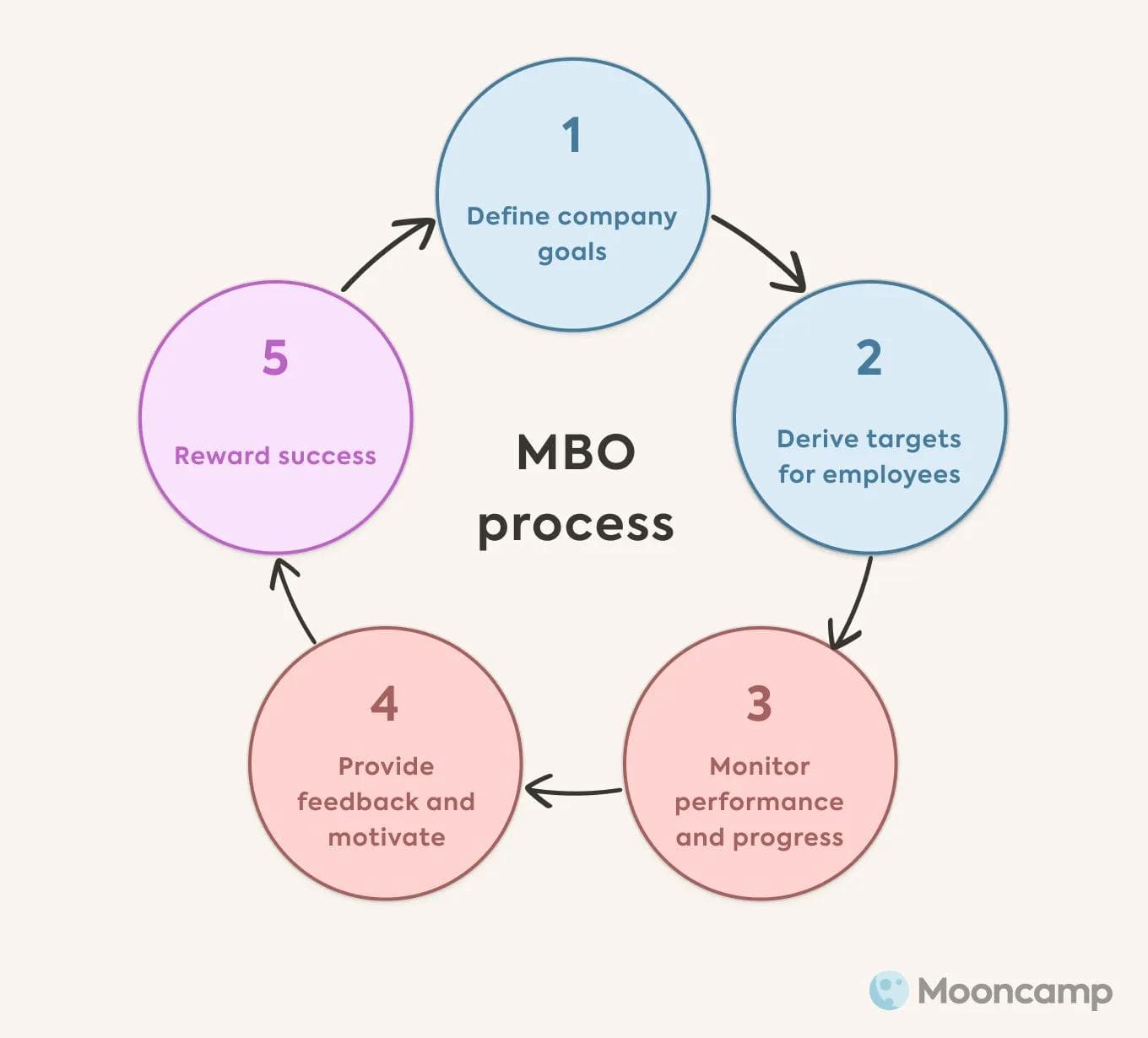
SMART– Goals
At its core, SMART goals are a concept that facilitates goal formulation and setting.
“SMART” is an acronym that stands for the first letters of five criteria for setting goals: Goals should always be specific, measurable, attainable, relevant, and time-bound.
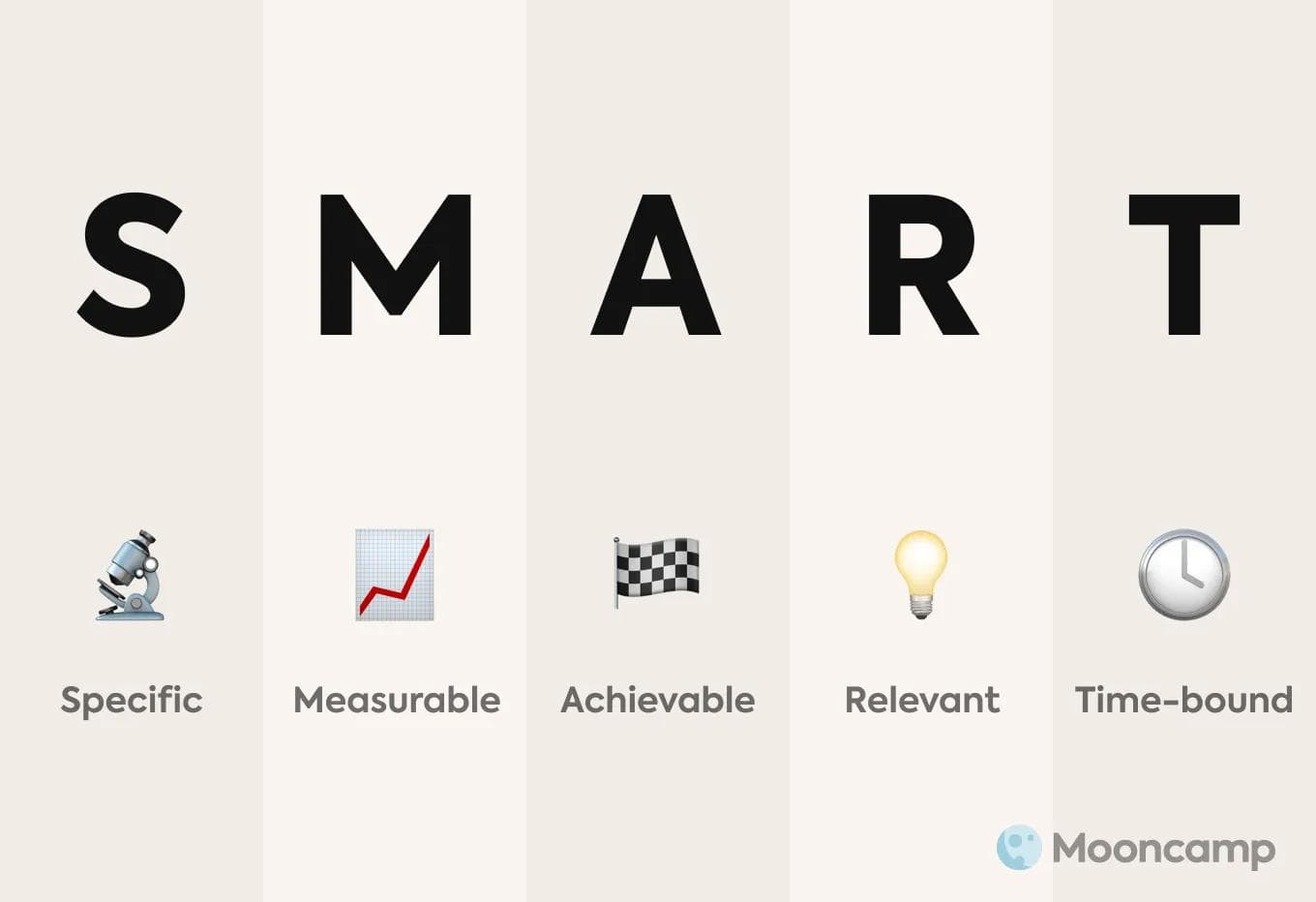
Objectives and Key Results (OKR)
OKR is an agile method for setting and implementing goals in companies. In this approach, Objectives are developed by both the leadership (top-down) and the individual teams (bottom-up). The Objectives are then carried out independently by the teams. The Objective’s achievement is measured through quantitative Key Results.
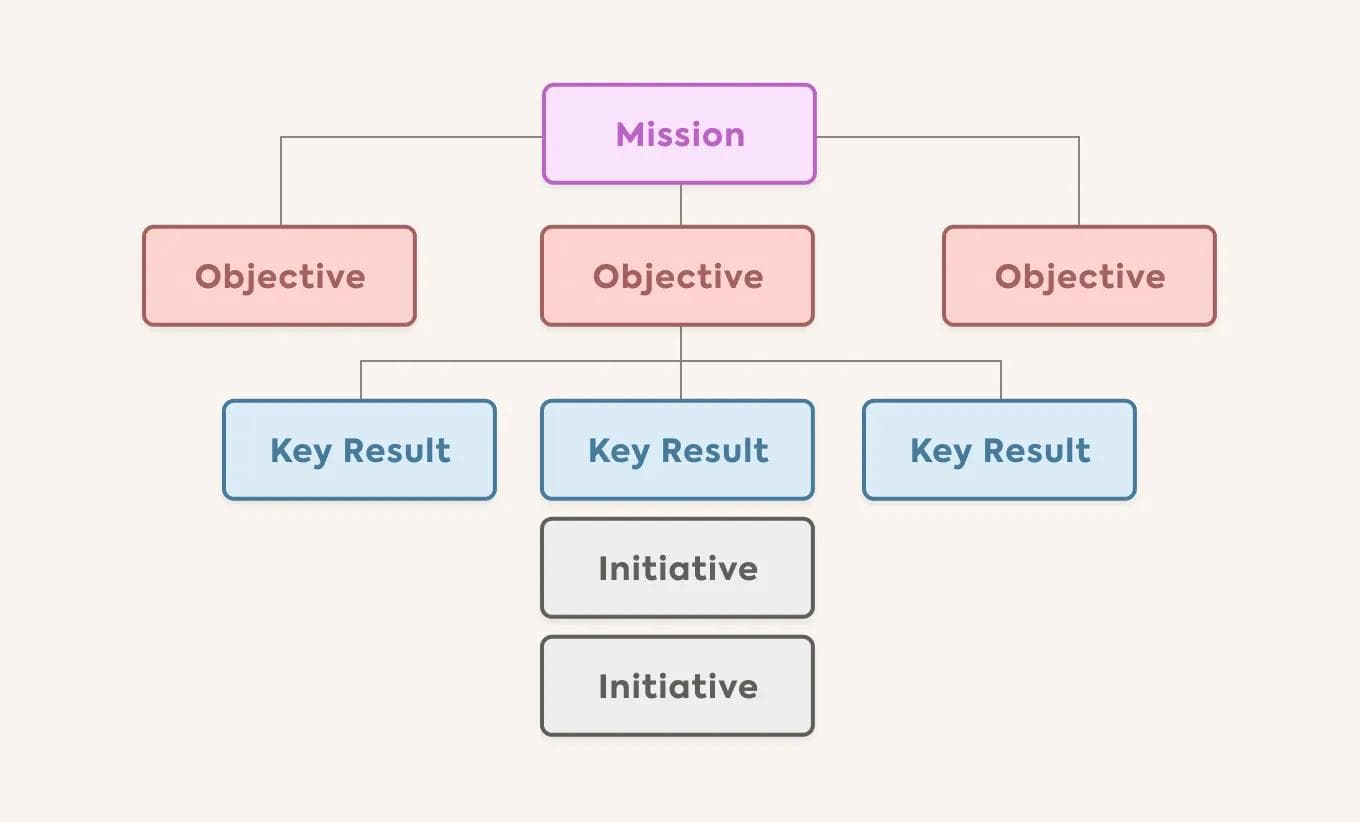
While the methodologies provide fixed steps and rules, the frameworks ensure that the company has a clear overview of the goals and help establish task guidelines. The combination of the two approaches can provide the company with clarity in terms of what needs to be done while also enabling creativity.
Combining the following frameworks with the aforementioned methodologies, can therefore simplify the management and execution of strategic goals.
Frameworks to manage strategic goals
Hoshin Kanri
The Japanese management approach, Hoshin Kanri, displays a company’s vision, strategies, and goals in a concise matrix. This matrix helps employees understand the strategic goal and enables them to work towards it.
Balanced Scorecard (BSC)
The Balanced Scorecard offers an overview of the company’s most important goals and directly links them to key performance indicators. The company’s performance is depicted from four different perspectives: Finance, Customers, Processes, and Development.
OGSM
The abbreviation “OGSM” stands for “Objectives, Goals, Strategies, and Measures”. In combination, these four elements form a widely used framework that can help companies transform their vision into an actionable business model and strategy.
Conclusion
Strategic goal setting can be extremely beneficial for companies, but only if it’s done right. This is why companies should use OKRs when setting strategic goals.
OKRs, or Objective and Key Results, can contribute to setting and managing strategic goals, prevent complications, and lead to success. Here is how:
Alignment and focus
OKRs provide a clear understanding of what needs to be accomplished and how success will be measured. This ensures that everyone in the organization is working towards the same strategic goals by connecting operational, tactical, and strategic objectives.
This alignment enables better communication, collaboration, and prioritization of tasks, ensuring that efforts are focused on the most critical initiatives.
Setting balanced goals with OKRs
OKRs encourage a mix of ambitious (stretch) Objectives and more attainable ones. This balance helps prevent the potential pitfalls of setting goals that are either too easy or too challenging, fostering a culture of innovation and growth while maintaining realistic expectations.
Transparency and accountability
OKRs can help by making goals and progress visible to everyone in the organization. This transparency helps create a sense of ownership and purpose among employees by connecting their work to the organization's strategic goals. This connection increases motivation and engagement, leading to higher productivity and better performance.
Additionally, the sense of responsibility also enables open communication and trust which in turn fosters a culture of accountability, as individuals and teams are aware of their roles and the impact of their work on the strategic goals.
Adaptability and improvement
As previously mentioned, strategic goals must be revised and adjusted repeatedly. OKRs help do exactly this, since they are designed to be reviewed and updated regularly, typically on a quarterly basis.
As such, OKRs promote a culture of continuous learning and improvement, which allows organizations to adapt to changing circumstances, learn from prior performance, and adjust their strategies accordingly.
The regular check-ins and OKR reviews also facilitate feedback loops and learning processes, as they help teams and individuals identify areas for growth. This continuous improvement process is crucial for achieving strategic goals and maintaining a competitive edge.
Measurable progress
Key Results provide specific, quantifiable metrics to evaluate progress towards objectives. This data-driven approach helps organizations identify areas for improvement, make informed decisions, and track the success of their strategic goals.
In sum, OKRs promote transparency, accountability, and continuous improvement. In doing so they contribute to the management and successful execution of strategic goals as well as the overall success of an organization
Strategic goal setting: FAQs
What are strategic goals examples?
Financial strategic goals:
- Increase the revenue by 25% in the next two years
- Increase market share by 10% in the next three years
- Reduce marketing costs by 5% in the next year
Marketing strategic goals:
- Diversify the company’s target group in the upcoming year
- Increase website traffic by 60% in the next two years
- Reach 2M followers on social media by 2024
Customer-Focused strategic goals
- Decrease Website bounce rate by 20% in the next year
- Increase customer retention by 10% by 2025
- Increase customer satisfaction by 5% in the next year
What are the 5 principles of goal setting theory?
Clarity: Goals should be specific about the desired outcome and what needs to be done to achieve them. Clear goals are measurable and leave no room for misunderstandings.
Challenge: Challenging goals can increase motivation. The key is balance: goals should be challenging but also achievable.
Commitment: All team members must be committed to the goal and work together towards it. The employee and employer must both agree on the resources needed to complete the goal and on what the reward will be
Feedback: Regular feedback encourages employees to ask questions and minimizes mistakes. By exchanging ideas and questions, employees can quickly find improvement possibilities and correct their errors.
Task complexity: If not properly understood, complex tasks can lead to confusion and demotivation. Employees should be allotted enough time to understand and accomplish complex tasks. Unreasonable time expectations can otherwise result in frustration and harm work efficiency levels.
What are the 8 major areas for strategic goals?
Products, services, customers, markets, finances, people, technology, and production capability should be considered when planning a future strategy. The development of these business areas depends on the business’s strategic goals.
